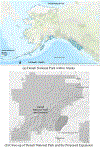How Valuable are National Parks? Evidence from a Proposed National Park Expansion in Alaska
- PMID: 31286114
- PMCID: PMC6613930
- DOI: 10.18666/JPRA-2019-8968
How Valuable are National Parks? Evidence from a Proposed National Park Expansion in Alaska
Abstract
When balancing environmental preservation and economic development, it is critical to evaluate how taxpayers value national park land and for what they are valuing it. One key component of this evaluation is to calculate a "passive use value," or the willingness to pay (WTP), for protection of land that may never directly be used, and to determine what benefits of land protection motivate this passive use value. We estimated the WTP for a 5% expansion of Denali National Park in Alaska (an expansion of 325,340 acres) using a questionnaire and the contingent valuation method. The survey first educated respondents on Alaskan geography, the current status of protected land and wildlife in Alaska, and common arguments for and against National Park expansion. The survey then described a proposal to expand the Denali National Park and asked a series of questions designed to bound the respondents WTP. Finally, the survey asked respondents to answer questions about what motivated their support or disapproval for the program. Multiple methodologies were used to estimate the national average WTP, resulting in a WTP range of a single payment of $77 to $409. This is estimated to be a total WTP of $15.1 billion to $79.3 billion for all individuals aged 18 to 64 in the United States, or $363.1 million to $1.91 billion per year in 2017 dollars. Respondents to the survey indicated that their support is driven primarily by increased protection from oil spills (85.8% deemed this very important or important), by increasing and protecting Alaska's biodiversity (84.3%), and preserving Alaska's beauty (84.2%). These results can help inform recent, current, and future debates about land use. President Obama significantly expanded land protections, while President Trump is continuing to scale back land protections, including opening up untouched land in Alaska in the Arctic National Wildlife Refuge for oil drilling. These results suggest that there are significant passive use values that should be considered when deciding whether to expand or reduce protection of land. Given that passive use values are significant, this suggests that the economic benefits must be large to tip a cost-benefit analysis in favor of reduced land protections.
Keywords: National Parks; biodiversity; contingent valuation; environmental policy; nature conservation; oil spills; willingness-to-pay.
Figures
Similar articles
-
Assessing the value of species: a case study on the willingness to pay for species protection in Chile.Environ Monit Assess. 2013 Dec;185(12):10479-93. doi: 10.1007/s10661-013-3346-5. Epub 2013 Aug 4. Environ Monit Assess. 2013. PMID: 23912424
-
Equitable sharing of benefits from tiger conservation: Beneficiaries' willingness to pay to offset the costs of tiger conservation.J Environ Manage. 2021 Apr 15;284:112018. doi: 10.1016/j.jenvman.2021.112018. Epub 2021 Feb 5. J Environ Manage. 2021. PMID: 33556825
-
Willingness to Pay for a Hypothetical COVID-19 Vaccine in the United States: A Contingent Valuation Approach.Vaccines (Basel). 2021 Apr 1;9(4):318. doi: 10.3390/vaccines9040318. Vaccines (Basel). 2021. PMID: 33915680 Free PMC article.
-
Willingness to pay for diagnostic technologies: a review of the contingent valuation literature.Value Health. 2013 Jul-Aug;16(5):797-805. doi: 10.1016/j.jval.2013.04.005. Epub 2013 Jun 14. Value Health. 2013. PMID: 23947973 Review.
-
Health care contingent valuation studies: a review and classification of the literature.Health Econ. 1998 Jun;7(4):313-26. doi: 10.1002/(sici)1099-1050(199806)7:4<313::aid-hec350>3.0.co;2-b. Health Econ. 1998. PMID: 9683092 Review.
Cited by
-
Establishing cost-effectiveness threshold in China: a community survey of willingness to pay for a healthylife year.BMJ Glob Health. 2024 Jan 9;9(1):e013070. doi: 10.1136/bmjgh-2023-013070. BMJ Glob Health. 2024. PMID: 38195152 Free PMC article.
References
-
- Alaska Department of Natural Resources. (2015). Denali State Park. Accessed July 5, 2017 from http://dnr.alaska.gov/parks/units/denali1.htm.
-
- Amigues JP, Boulato C, Desaigues B, Gauthier C & Keith J (2002). The benefts and costs of riparian analysis habitat preservation: a willingness to accept/willingness to pay contingent valuation approach. Ecological Economics, 43: 17–31.
-
- Baranzini A, Faust AK, & Huberman D (2010). Tropical forest conservation: Attitudes and preferences. Forest policy and economics, 12(5), 370–376.
-
- Bateman IJ (1996). An economic comparison of forest recreation, timber and carbon fixing values with agriculture in Wales: a geographical information systems approach (Doctoral dissertation, University of Nottingham).
-
- Bateman IJ, & Langford IH (1997). Non-users’ Willingness to Pay for a National Park: An Application and Critique of the Contingent Valuation Method. Regional Studies, 31(6): 571–582.
Grants and funding
LinkOut - more resources
Full Text Sources




